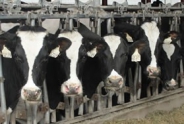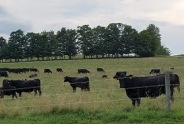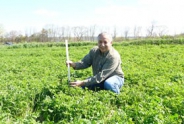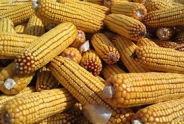EIDL Loan Program Information-Fact Sheet #5
Nicole Tommell, Area Ag Business Management Specialist/Team Leader
Central New York Dairy and Field Crops
To be honest, when we wrote the last fact-sheet at the end of April, we were not optimistic that the EIDL would be open to farms in the near future. Therefore, we didn't spend a lot of time analyzing the program for you. But, never say never, because like a monster in a horror movie - just when you think it's down for the count - the EIDL is back! Last Monday the 4th the SBA application portal for EIDL opened again, for farms only. This fact sheet provides more information about the EIDL program. We also want to go over some PPP program updates, including availability of the program and changes to how monthly average wages are calculated for seasonal employers (to the benefit of NYS farms).
PPP Update - It's not too late to apply!
According to the Wall Street Journal on Friday, May 8th, SBA reported on 5/8/20 that only 40% of the second round of Paycheck Protection Program (PPP) funding had been obligated. Therefore, farms that are on the fence about applying still have time to take advantage of this program. It seems that several things have happened to make the funding more available. First, the program in the second round was made much less attractive to large, publicly traded companies. According to the SBA report, the average loan size in the first round was $210,000 and in the second round it is only $73,000, indicating that this second round has done a better job reaching small businesses. Second, it turns out that many applicants had PPP applications in at multiple banks to increase their odds of success. As these duplicate applications come to light, more funding that was formerly thought to be obligated is freed up. More large companies have returned the PPP funds that they received, due to new guidance from the Treasury Department. Finally, some firms are deciding that they are less interested in the loan program as questions about how much of the loan will be forgivable arise or those who needed it most have already applied for PPP funding.
More changes to the PPP are likely to take place, and some may be to your advantage. For example, because many businesses are not able to fully open, and therefore can't hire back their workers soon, there is Congressional pressure to increase the percentage of utilities, interest and rent that can be forgiven. The SBA Inspector General Mike Ware issued a report on the PPP on May 8th, 2020 which was critical of the SBA restrictions added to the PPP requiring 75% of the forgivable portion of the loan to be used for payroll. He stated that this restriction puts an unintended burden on borrowers, and that "tens of thousands of borrowers would not meet the 75% threshold." In the report, Ware recommended that the SBA "evaluate the potential negative impact to borrowers" regarding the percentage of loan proceeds eligible for forgiveness and update the requirements, as necessary. "It may be important to consider that many small businesses have more operational expenses than employee expenses," he said. The report can be found here.
Should you apply? Most of you will be paying salary and fringe (for yourself at least), utilities, interest and rent for the 8 weeks after the loan is disbursed. You will also likely continue to incur these expenses all year. These are all items that will be forgivable. This loan would free up cash you have on hand to deal with other unexpected expenses this season. Whatever parts of the loan are ultimately not forgivable are a 1% loan for expenses you will likely incur. Farming is always uncertain and predicting the impacts of COVID-19 on farms in New York moves us into unknown territory. Your workers could get sick, you may need to pay more for cleaning supplies, masks, and other safety measures. Farms that rely on direct sales to the public and agritourism may experience lower revenues. Restaurant sales may be lower. Unless you are already sitting on a big pile of cash or can access funding at a better interest rate than 1%, having extra cash available during a season with a lot of uncertainty seems like a good risk management strategy, especially when some or all of it may be forgiven. BUT you also should be aware that these programs may have tax implications1 for your business. The tax implications of these programs are issues that are currently being discussed in the federal agencies and in Congress.
Don't forget that forgiveness will depend on having good records of payment of allowable expenses. A best practice would be to make a file for your PPP loan and keep a copy of all documentation of your expenses and payments for allowable expenses for 2020. Keep records of payments of all allowable expenses, payroll, rent, utilities, and interest.
There has been a change in the PPP to give seasonal employers, whose peak months for employment are in the summer, a better opportunity to access a larger PPP loan. This change could be very beneficial to NYS fruit and vegetable farms. Originally the PPP gave employers the option of using the monthly average of annual wages for the loan amount or their monthly average payments for payroll during ‘‘the 12-week period beginning February 15, 2019, or at the election of the eligible [borrower], March 1, 2019, and ending June 30, 2019. The Treasury Dept. issued a rule on April 30 to address this by allowing seasonal employers to use an alternative base period for purposes of calculating the loan amount for which they are eligible under the PPP. A seasonal employer now has the option of using any consecutive 12- week period between May 1, 2019 and September 15, 2019 for determining its maximum loan amount. As required by section 1109(d)(2)(B), Treasury has determined that this alternative period for seasonal employers is, to the ‘‘maximum extent practicable,'' consistent with the terms applicable to the PPP in general. By permitting seasonal employers to calculate the maximum loan amount using any consecutive 12 weeks within a specified 4.5-month period, this interim final rule ensures that seasonal employers affected by the pandemic are treated even-handedly. Other than this adjustment, the terms and requirements applicable to PPP loans under this rule are identical to the terms and requirements that section 1102 and SBA regulations impose on other PPP loans.
EIDL Program
Now on to the SBA Emergency Income Disaster Loan (EIDL). The first thing we want to mention with the EIDL is the Advance, which was authorized in the CARES Act. The CARES Act added the ability for businesses applying for EIDL to receive up to $10,000 as an advance on their loan to "provide economic relief to business experiencing a temporary loss of revenue." This advance does not need to be paid back and is effectively a grant of up to $10,000 ($1,000 for every employee in the business up to $10,000). When you apply for the EIDL, if you are found to be eligible for EIDL loans, you receive the Advance quickly, before the loan is approved. If you are ultimately not approved for an EIDL, you still get to keep the Advance. Last week farms that were applying to EIDL were reporting receiving the Advance quickly.
The loan portion of the EIDL is the SBA's primary disaster assistance program to businesses. It provides low interest loans (3.75%) for working capital that are intended to help a business keep going during a period of business interruption due to a disaster. Although businesses usually can apply for up to $2 million in EIDL funding, there are reports that SBA has recently lowered the lending limit to $150,000 2. The terms for repayment of the loan can be quite long (up to 30 years) with the intention that the repayment costs are low enough to help the business stay economically viable after the disaster.
Uses of EIDL funds are also very flexible. It is almost easier to say what you CAN'T do with EIDL than what you can. You can't use the EIDL funds to enrich the owners of the company. For example, you can't pay dividends or bonuses, you can't give the money to the business owners - except for payment of services, you can't use the money to repay stockholder or principal loans (unless the loans were due to the disaster and it would cause undue hardship to the stockholder/principal). You can't use the money to expand the business or buy fixed assets, you can't repair or replace physical damage, you can't refinance long-term debt and you can't use it to relocate.
The funds for the EIDL come directly from the US Treasury. Because it has been around for many years, the EIDL program is more like a traditional lending program and less the wild west than the PPP. What you can borrow for EIDL is dependent on your credit and ability to offer collateral for the loan. The maximum unsecured loan is $25,000.
SBA will look at:
• Your eligibility (meet the requirements for an EIDL loan)
• Your credit history - if you have bad credit or not credit history you may have trouble getting and EIDL loan
• Your ability to repay the loan - a business that was failing before the disaster is not a strong candidate for an EIDL loan. The loan is intended to help an otherwise strong business get through the disaster, not to put an otherwise failing business on life support.
• That your business was (is) impacted by the disaster.
So, what does that mean as far as your ability to access EIDL vs PPP? With EIDL you go through SBA, who will be just looking at your information against a set of lending standards. With PPP you may be working with a bank that knows your business and that bank is also receiving a 100% guarantee by the federal government. Banks will not give loans to applicants who obviously are poor candidates for credit, they do have a fiscal responsibility to vet applicants and reject candidates who are obviously not credit worthy or who do not meet the lending standards of the program - but there are applicants in the grey area. Because you can work with a bank that knows you and your business, PPP may be more accessible if you have credit areas where you are weaker.
EIDL and PPP How do they Work Together?
You can apply for both the PPP and the EIDL and because the programs are so competitive if you need this help for your business is probably worth applying to both, just in case you are not able to access the other program. However, you cannot use the funds for the same purpose. So, if you do receive a PPP loan, it would be to your benefit to first use the PPP loan funds for salary because that use of the PPP is forgivable and uses of the PPP are more restricted. EIDL loans, for example, can be used to pay vendors and pay other operating costs.
If you received or receive a PPP loan, the amount of the PPP loan that will be forgiven is reduced by the amount of the Advance. So, if you received a PPP loan with a forgivable amount of $20,000, and then get an EIDL advance for $10,000, your PPP loan forgiveness will be reduced to $10,000. You will pay the rest of the PPP back at 1%. However, the uses of the EIDL Advance are much broader than the PPP. For many businesses that is a good trade-off. For example, if you have a large seed bill due or need to pay a vendor you can likely use your EIDL Advance, but not the PPP loan.
There is a chart summarizing the differences between the two assistance programs in the pdf.
It is important to remember that these two programs are not the only forms of assistance available.
Many local areas are also developing emergency loan and grant programs for businesses, so it may be
worth looking closer to home - especially if the amount of funding you need is more in the under
$10,000 range. Also, don't forget that there are COVID-19 related tax benefits as well as USDA
loan and assistance programs forthcoming.
Resources
• Link to EIDL Loan Application and Information
• Link to SBA information for PPP
• SBA Paycheck Protection Program (PPP) report: Approvals from 4/27/2020 through 05/08/2020
• Federal Register 85(84) 4/30/20 Small Business Administration Business Loan Program Temporary Changes; Paycheck Protection Program—Additional Criterion for Seasonal Employers Interim Final Rule
• Paycheck Protection Program FAQ (constantly updated by SBA and the Treasury Dept)
Prior Fact Sheets:
• Fact Sheet #1 CARES Act's Emergency Resources for Farm Businesses: Paycheck Protection Loan Program, April 2, 2020
• Fact Sheet #2 April 8th Update to the Paycheck Protection Program (PPP) - Where the only constant is change!, April 8, 2020
• Fact Sheet #3 A new interim rule, the first round of funding is depleted. What does the future hold? April 14, 2020
• Fact Sheet #4 PPP has$310 billion more + returned funds from large companies. $60 billion more for EIDL, is now available(ish) for farms. April 27, 2020
PPP5EIDL (pdf; 358KB)
Upcoming Events
2025 Dairy Day
January 7, 2025 : Dairy Day - Hamilton
Hamilton, NY
New Location! Lunch Included!
January 8, 2025 : Dairy Day - Ballston Spa
Ballston Spa, NY
Lunch Included!
Corn & Soybean Day
January 14, 2025 : Corn & Soybean Day - Hamilton
Hamilton, NY
New Location! Lunch included! 2.75 DEC Credits available!
January 15, 2025 : Corn & Soybean Day - Ballston Spa
Ballston Spa, NY
New Location! Lunch included! 2.75 DEC Credits available!
Farm Succession Planning Webinar
January 22, 2025 : Farm Succession Planning Webinar
Free webinar
Announcements
Sign Up for Our Weekly E-Newsletter
We send out a bi-weekly e-newsletter that has announcements, upcoming programs, and opportunities for you! Registration is quick, easy, and free. Click here to sign up today!Document and Share Storm Damage
Mother nature has really been difficult over the last few days. Significant damage has been seen throughout NYS. Please let us know what types of damage your farm may have sustained during this time. This could be in the form of property damage, lost power, milk dump due to lost power, loss of livestock, loss of stored feed or growing crops.Farms are encouraged to DOCUMENT AND SHARE any impacts the weather may have had on their home or business. This could include structure damage, crop loss, inventory loss due to power outages, damage to equipment or fencing, and more.
If your farm experienced any sort of damage, please reach out to any of the folks listed below (or all of them). The more impact information that is collected, the greater the likelihood of a disaster declaration which can bring vital emergency support and awareness. The CNYDLFC Team will continue to collect detail and submit to NYSDAM and the EDEN network.
Reporting Weather Related Impacts (For your home or farm business)
- First, ensure that all the people and animals on your farm are safe, and that there aren't any unsafe working conditions created because of the weather (check your structures!). If there's an emergency, call 911 - don't try to manage it all on your own.
- Second, document all negative weather impacts for your farm and their estimated financial cost. Take photos, make estimates, and put it all in a safe place.
- Reach out to your insurance providers - farm, vehicle, crop, etc. to initiate the claim process as needed.
- Then, share your farm's damage with any (or all) of the ag support agencies listed below. We all work together to collect storm damage information and funnel it up to Ag and Markets which can initiate a natural disaster declaration.
- Chenango: 607-334-5841
- Fulton/Montgomery: 518-853-2135
- Herkimer: 315-866-7920
- Madison: 315-684-3001
- Otsego: 607-547-2536
- Schoharie: 518-234-4303
- Saratoga: 518-885-8995
- Erik Smith: 315-219-7786
- Daniela Gonzalez: 315-749-3486
- Ashley McFarland- 315-604-2156
Your county USDA/FSA service center.
- Chenango: 607-334-3231
- Fulton/Montgomery: 518-853-4015
- Herkimer: 315-866-2520
- Madison:315-824-9076
- Otsego: 607-547-8131
- Schoharie: 518-295-8600
- Saratoga: 518-692-9940
Your county farm bureau manager
- Region 3: Bailey Coon: 518-937-0566
- Region 5: John Wagner: 315-761-9770
- Region 6: Natally Batiston: 518-937-0269
- Region 7: Todd Heyn: 518-431-9338
Please let us know how we can help you.
Cash Rent and Custom Harvest Survey
To date, there is limited information available about rental rates and fees for crop harvesting. Farms can use this valuable information for their farm business planning to help improve decision making and profitability.Farmers Can Join MeatSuite For Free!
MeatSuite.com is a free resource provided by Cornell University where NY meat farmers can create a farm profile and list their bulk (wholes, halves, quarters) and bundled (i.e. Grilling Bundle) meat products.Why should farmers join?
1. It's free and easy!
2. Connect with more local customers. In the past year the MeatSuite.com farm directory had 8,300 visits from New York consumers. Farm profiles get as many as 25 views per month from potential local customers. We also spotlight MeatSuite farms on social media and bring attention and purchases to farms through highlights and giveaways.
How do I join?
Farmers can visit https://www.meatsuite.com/farmers/ to create a free farm profile. You must list at least one product for your farm's profile to go live. You'll also have access to Cornell's free Meat Price Calculator, a helpful tool for pricing your meat to make a profit.
While you're on MeatSuite, check out the "Creating Consumer-Friendly Bulk Meats" publication on the log-in page. It has tips on how to create bulk meat products that are easier for first-time buyers to say "yes" to.
If you have any questions as you create your farm profile or products, we're here to help! Please email Matt LeRoux at mnl28@cornell.edu.




